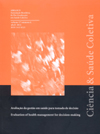0349/2012 - Climatic variables, living conditions and population health: leptospirosis in the city of Rio de Janeiro from 1996 to 2009
Variáveis climáticas, condições de vida e saúde da população: a leptospirose no Município do Rio de Janeiro de 1996 a 2009
Author:
• TERESA VIEIRA DOS SANTOS DE OLIVEIRA - Oliveira, Teresa V - RIO DE JANEIRO, RIO DE JANEIRO - FIOCRUZ - <tevis@ensp.fiocruz.br>Co-author(s):
• Diana Pinheiro Marinho - Marinho, D. P. - PMAGS/DCB/ENSP/FIOCRUZ - <diana@ensp.fiocruz.br>• Cristina Costa Neto - Costa Neto, C. - PMAGS/DCB/ENSP/FIOCRUZ - <ccneto@fiocruz.br>
• Débora Cynamon Kligerman - Débora Cynamon Kligerman - Rio de Janeiro, RJ - DSSA/ENSP/FIOCRUZ - <kliger@ensp.fiocruz.br>
Thematic Area:
Saúde e AmbienteAbstract:
The extreme weather events have a strong impact on people‘s health, especially when it produces disease or even cause accidents victims.The population of Rio de Janeiro is vulnerable in the face of climate variability, mainly for their socio-economic aspect, because the city has a topography and climate that favors this vulnerability.
This article discusses the development of disease in the municipality of Rio de Janeiro, the thirty-two administrative regions, in the period 1996-2009, testing the hypothesis that climatic variations lead to an increase in the number of cases of the disease.
The meteorological data used were provided by the National Institute of Meteorology and by the Brazilian Infrastructure Aero-Port Data on morbidity and mortality of disease was collected from the Municipal Health and Civil Defense / RJ.
In this work, it was concluded that no correlation between the incidence of leptospirosis and rainfall. However, in the end, it is emphasized that the oscillation of the number of cases is not only determined by rainfall, other factors influence this dynamic, such as sanitation, environment and social.











